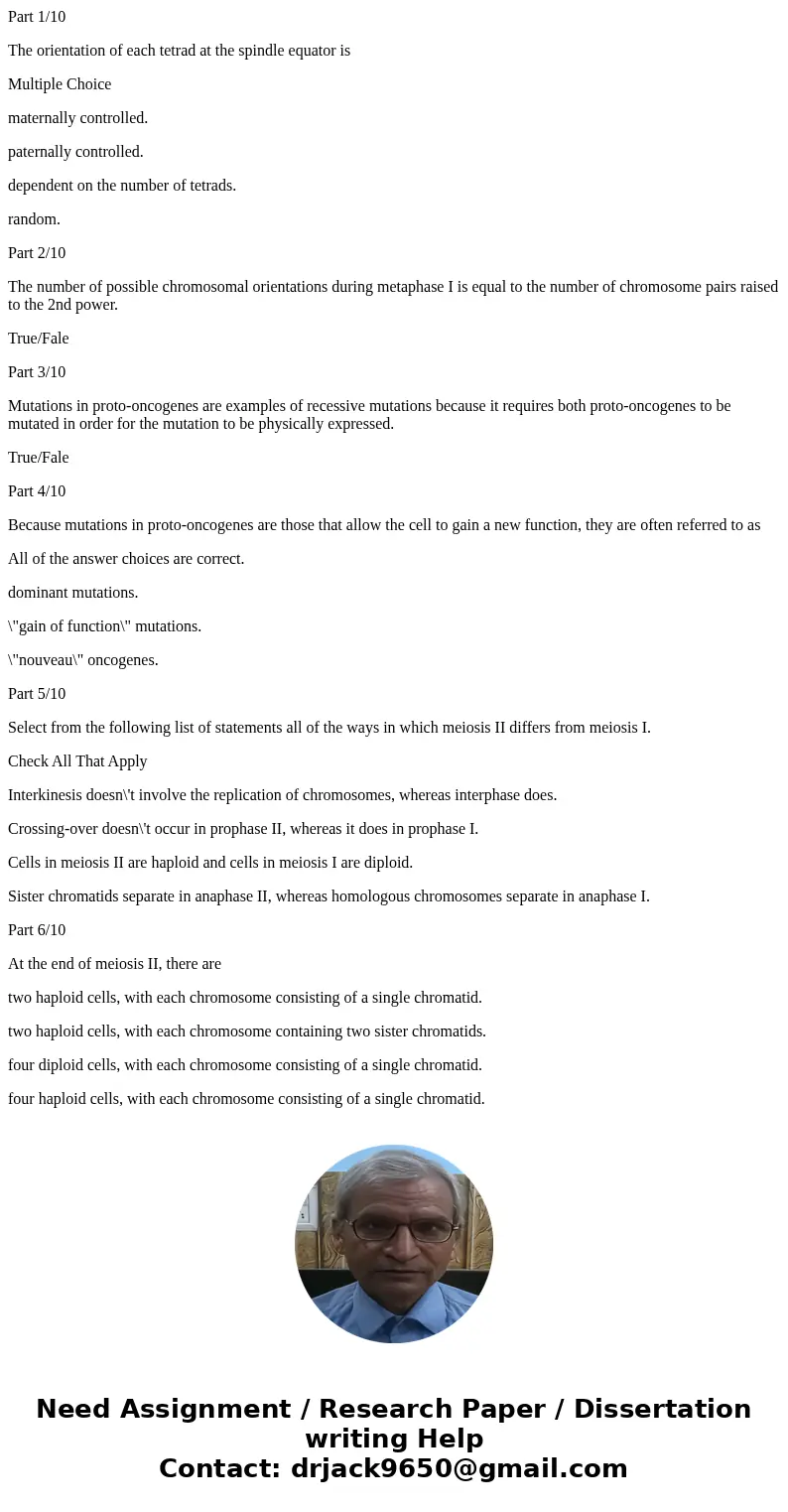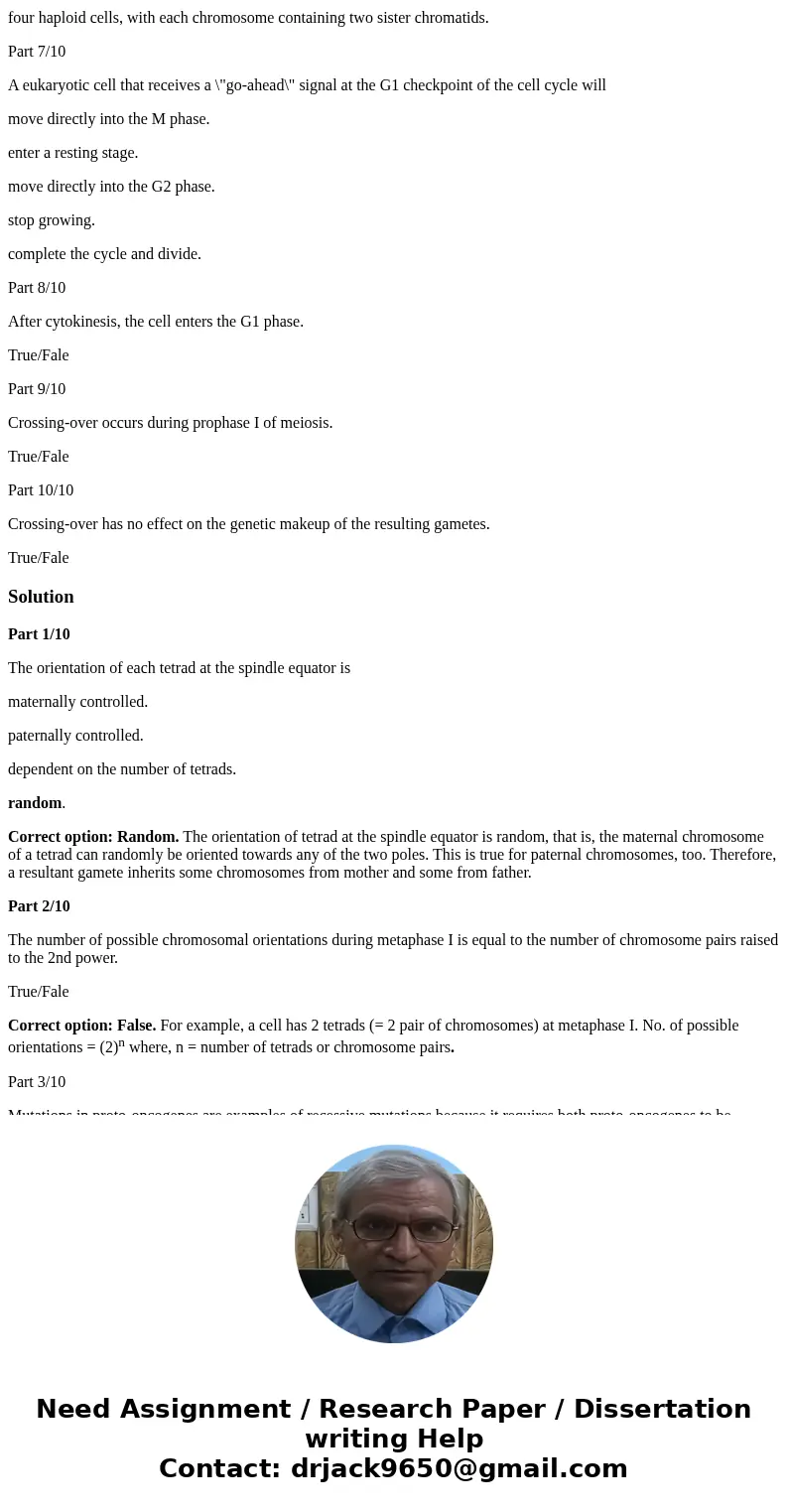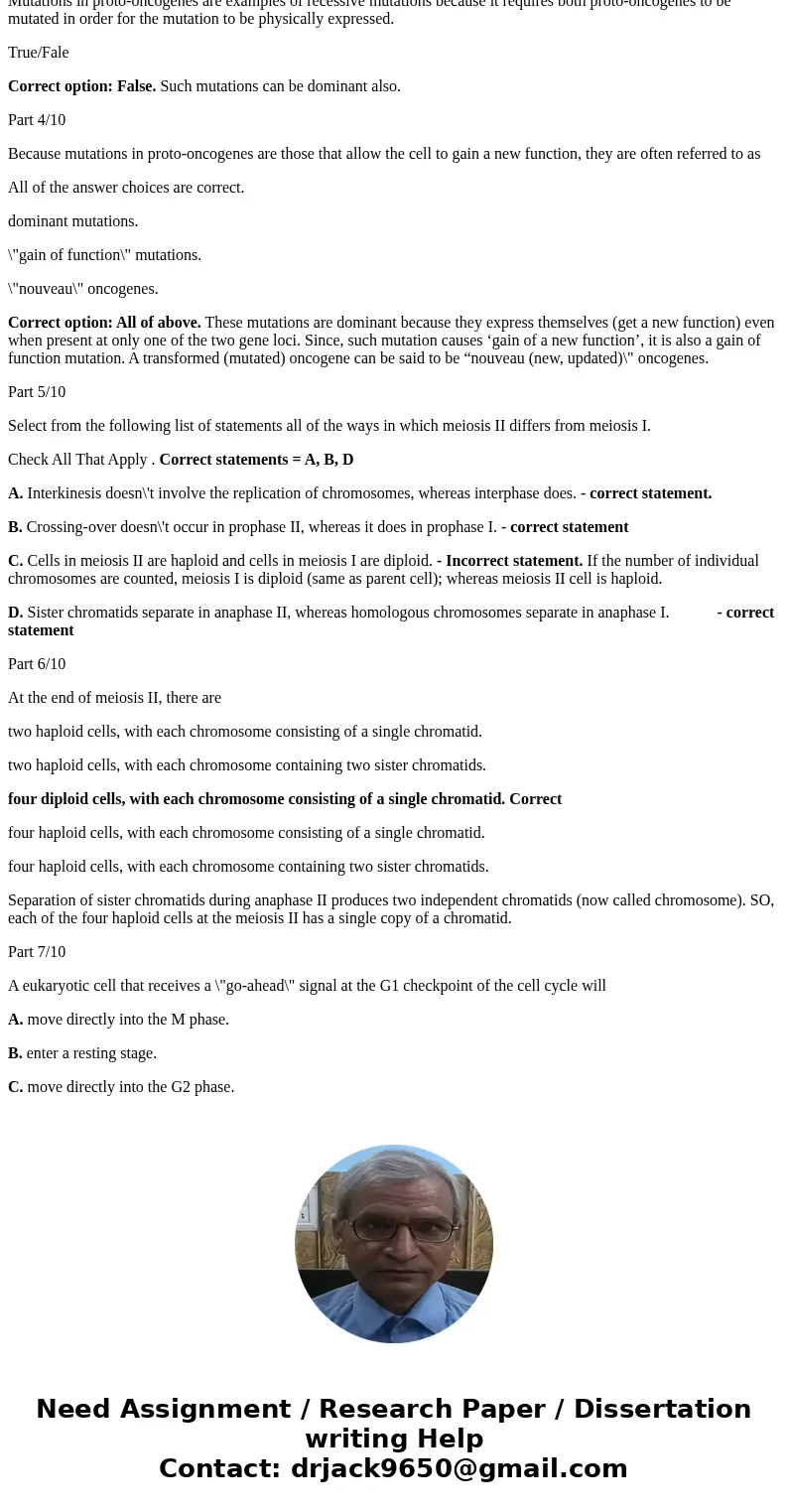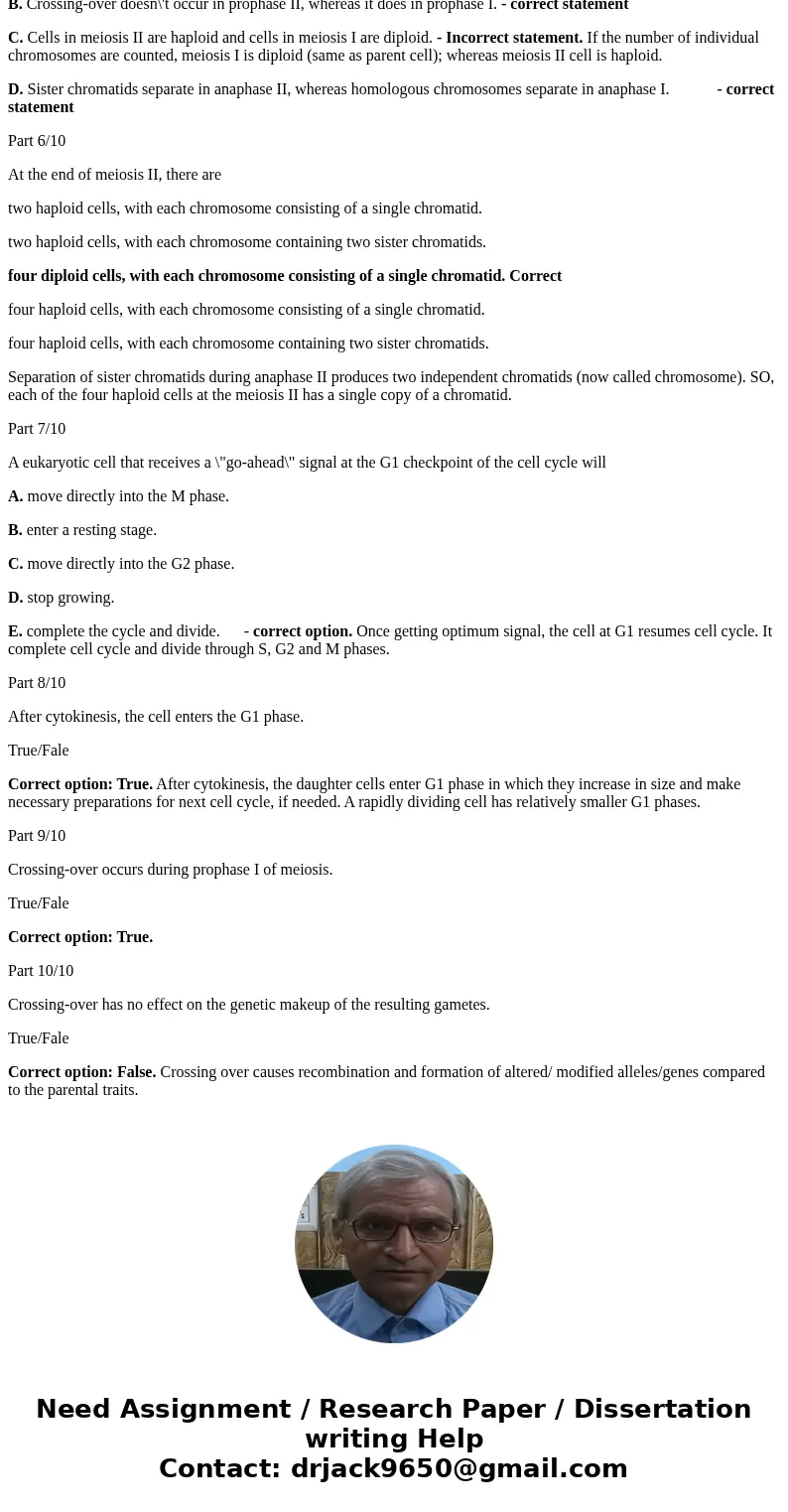Part 110 The orientation of each tetrad at the spindle equat
Part 1/10
The orientation of each tetrad at the spindle equator is
Multiple Choice
maternally controlled.
paternally controlled.
dependent on the number of tetrads.
random.
Part 2/10
The number of possible chromosomal orientations during metaphase I is equal to the number of chromosome pairs raised to the 2nd power.
True/Fale
Part 3/10
Mutations in proto-oncogenes are examples of recessive mutations because it requires both proto-oncogenes to be mutated in order for the mutation to be physically expressed.
True/Fale
Part 4/10
Because mutations in proto-oncogenes are those that allow the cell to gain a new function, they are often referred to as
All of the answer choices are correct.
dominant mutations.
\"gain of function\" mutations.
\"nouveau\" oncogenes.
Part 5/10
Select from the following list of statements all of the ways in which meiosis II differs from meiosis I.
Check All That Apply
Interkinesis doesn\'t involve the replication of chromosomes, whereas interphase does.
Crossing-over doesn\'t occur in prophase II, whereas it does in prophase I.
Cells in meiosis II are haploid and cells in meiosis I are diploid.
Sister chromatids separate in anaphase II, whereas homologous chromosomes separate in anaphase I.
Part 6/10
At the end of meiosis II, there are
two haploid cells, with each chromosome consisting of a single chromatid.
two haploid cells, with each chromosome containing two sister chromatids.
four diploid cells, with each chromosome consisting of a single chromatid.
four haploid cells, with each chromosome consisting of a single chromatid.
four haploid cells, with each chromosome containing two sister chromatids.
Part 7/10
A eukaryotic cell that receives a \"go-ahead\" signal at the G1 checkpoint of the cell cycle will
move directly into the M phase.
enter a resting stage.
move directly into the G2 phase.
stop growing.
complete the cycle and divide.
Part 8/10
After cytokinesis, the cell enters the G1 phase.
True/Fale
Part 9/10
Crossing-over occurs during prophase I of meiosis.
True/Fale
Part 10/10
Crossing-over has no effect on the genetic makeup of the resulting gametes.
True/Fale
Solution
Part 1/10
The orientation of each tetrad at the spindle equator is
maternally controlled.
paternally controlled.
dependent on the number of tetrads.
random.
Correct option: Random. The orientation of tetrad at the spindle equator is random, that is, the maternal chromosome of a tetrad can randomly be oriented towards any of the two poles. This is true for paternal chromosomes, too. Therefore, a resultant gamete inherits some chromosomes from mother and some from father.
Part 2/10
The number of possible chromosomal orientations during metaphase I is equal to the number of chromosome pairs raised to the 2nd power.
True/Fale
Correct option: False. For example, a cell has 2 tetrads (= 2 pair of chromosomes) at metaphase I. No. of possible orientations = (2)n where, n = number of tetrads or chromosome pairs.
Part 3/10
Mutations in proto-oncogenes are examples of recessive mutations because it requires both proto-oncogenes to be mutated in order for the mutation to be physically expressed.
True/Fale
Correct option: False. Such mutations can be dominant also.
Part 4/10
Because mutations in proto-oncogenes are those that allow the cell to gain a new function, they are often referred to as
All of the answer choices are correct.
dominant mutations.
\"gain of function\" mutations.
\"nouveau\" oncogenes.
Correct option: All of above. These mutations are dominant because they express themselves (get a new function) even when present at only one of the two gene loci. Since, such mutation causes ‘gain of a new function’, it is also a gain of function mutation. A transformed (mutated) oncogene can be said to be “nouveau (new, updated)\" oncogenes.
Part 5/10
Select from the following list of statements all of the ways in which meiosis II differs from meiosis I.
Check All That Apply . Correct statements = A, B, D
A. Interkinesis doesn\'t involve the replication of chromosomes, whereas interphase does. - correct statement.
B. Crossing-over doesn\'t occur in prophase II, whereas it does in prophase I. - correct statement
C. Cells in meiosis II are haploid and cells in meiosis I are diploid. - Incorrect statement. If the number of individual chromosomes are counted, meiosis I is diploid (same as parent cell); whereas meiosis II cell is haploid.
D. Sister chromatids separate in anaphase II, whereas homologous chromosomes separate in anaphase I. - correct statement
Part 6/10
At the end of meiosis II, there are
two haploid cells, with each chromosome consisting of a single chromatid.
two haploid cells, with each chromosome containing two sister chromatids.
four diploid cells, with each chromosome consisting of a single chromatid. Correct
four haploid cells, with each chromosome consisting of a single chromatid.
four haploid cells, with each chromosome containing two sister chromatids.
Separation of sister chromatids during anaphase II produces two independent chromatids (now called chromosome). SO, each of the four haploid cells at the meiosis II has a single copy of a chromatid.
Part 7/10
A eukaryotic cell that receives a \"go-ahead\" signal at the G1 checkpoint of the cell cycle will
A. move directly into the M phase.
B. enter a resting stage.
C. move directly into the G2 phase.
D. stop growing.
E. complete the cycle and divide. - correct option. Once getting optimum signal, the cell at G1 resumes cell cycle. It complete cell cycle and divide through S, G2 and M phases.
Part 8/10
After cytokinesis, the cell enters the G1 phase.
True/Fale
Correct option: True. After cytokinesis, the daughter cells enter G1 phase in which they increase in size and make necessary preparations for next cell cycle, if needed. A rapidly dividing cell has relatively smaller G1 phases.
Part 9/10
Crossing-over occurs during prophase I of meiosis.
True/Fale
Correct option: True.
Part 10/10
Crossing-over has no effect on the genetic makeup of the resulting gametes.
True/Fale
Correct option: False. Crossing over causes recombination and formation of altered/ modified alleles/genes compared to the parental traits.




 Homework Sourse
Homework Sourse